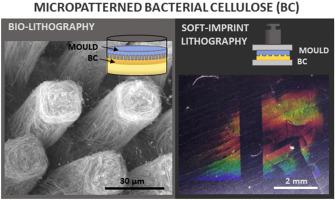Materials Today Chemistry ( IF 6.7 ) Pub Date : 2021-08-25 , DOI: 10.1016/j.mtchem.2021.100535 S. Roig-Sanchez 1 , C. Fernández-Sánchez 2, 3 , A. Laromaine 1 , A. Roig 1

|
Bacterial cellulose (BC) is a biocompatible polysaccharide produced by bacteria currently used in packaging, cosmetics, or health care. A highly attractive feature of BC is the possibility of patterning the BC pellicle during its biosynthesis, a concept coined as bio-lithography. BC-patterned films have demonstrated improved properties for cellular-guided growth, implant protection, or wound dressing. However, aspects such as the diversity and size of the features patterned, how those features withstand postprocessing steps, or if large areas can be patterned remain unanswered. Gathering knowledge on these characteristics could extend the use of patterned cellulose-based materials in emerging fields such as transient devices, nanogenerators, or microfluidics. Here, we show that bio-lithographed BC films present good-quality micropatterned features for various motifs (wells, pillars, and channels) in a wide range of sizes (from 200 to 5 μm) and areas as large as 70 cm2. Besides, we have studied the fidelity of the motifs and the fiber organization for wet, supercritical, and oven-dried films. When wells and pillars were patterned, the x and y dimensions were faithfully replicated in the wet and dried samples, but only wet and supercritically dried films afforded mold accuracy in the z-direction. In addition, x/z ratio should be carefully considered for obtaining self-standing pillars. Finally, we compared bio-lithography and soft-imprint lithography. In the latter case, fiber alignment was not observed and the depth of the resulting features dramatically decreased; however, this technique allowed us to produce submicron features that remain after the rewetting of the BC films.
中文翻译:

细菌纤维素膜上的生物和软压印光刻
细菌纤维素 (BC) 是一种生物相容性多糖,由目前用于包装、化妆品或保健品的细菌产生。BC 的一个极具吸引力的特征是可以在其生物合成过程中对 BC 薄膜进行图案化,这一概念被称为生物光刻。BC 图案薄膜已证明在细胞引导生长、植入物保护或伤口敷料方面具有改进的特性。然而,诸如图案化特征的多样性和大小、这些特征如何承受后处理步骤或是否可以对大面积进行图案化等方面仍未得到解答。收集有关这些特性的知识可以扩展基于图案的纤维素材料在瞬态装置、纳米发电机或微流体等新兴领域的使用。这里,2 . 此外,我们还研究了湿膜、超临界膜和烘干膜的图案保真度和纤维组织。当孔和柱子被图案化时,x 和 y 尺寸在湿样品和干样品中被忠实地复制,但只有湿和超临界干燥的薄膜才能在 z 方向提供模具精度。此外,为了获得自立柱,应仔细考虑 x/z 比。最后,我们比较了生物光刻和软压印光刻。在后一种情况下,未观察到纤维排列,并且所得特征的深度显着降低;然而,这种技术使我们能够产生在 BC 薄膜再润湿后仍然存在的亚微米特征。









































 京公网安备 11010802027423号
京公网安备 11010802027423号